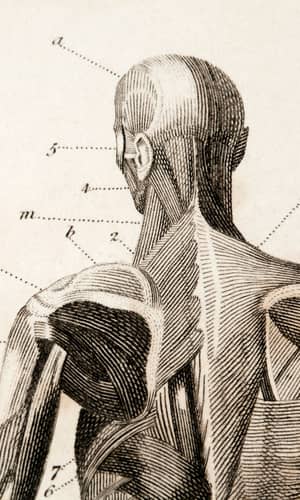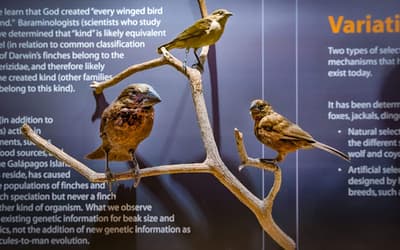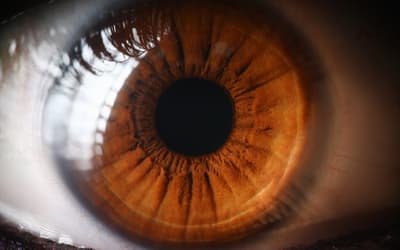The views expressed in this paper are those of the writer(s) and are not necessarily those of the ARJ Editor or Answers in Genesis.
Abstract
We have been created fearfully and wonderfully by our Creator God, and the human body showcases God’s intricate design. Design features are evident in the structures and functions of each of the body systems. In this paper, I present a design approach to the study of human anatomy and physiology from a biblical worldview. I establish a theology of the body as a foundation for the study of human structure and function. I then discuss key repeating themes in the human body systems as evidence for design and offer suggestions for biblical integration in the study of these themes. I also highlight the concept of overdesign in the human body as evidence for a Great Designer. I conclude the paper with a discussion of ways that a design approach to the study of anatomy and physiology could inspire praise, promote deeper reflection on God and His creation, and encourage a holistic view of stewardship of the body.
Keywords: design, anatomy, physiology, biblical integration
Introduction
Study of human structure and function from a biblical worldview is centered on God’s intricate design. We are fearfully and wonderfully made by the sovereign Designer/Creator, and this truth is evident from the molecular to the systemic levels of organization. Scientific discoveries over the past century point even more convincingly to a creation and design model of human origin (Jeanson 2017).
As a professor at a Christian liberal arts university, I approach the teaching of human structure and function from a biblical worldview using a design approach. I wrestle with the question of how a biblical worldview connects with the disciplines of anatomy and physiology as I seek to incorporate faith-learning integration in the classroom. My intent is to approach faith-learning integration as “a scholarly project whose goal is to ascertain and to develop integral relationships which exist between the Christian faith and human knowledge, particularly as expressed in the various academic disciplines” (Hasker 1992, 234). In this paper, I will examine some of these integral relationships between the Christian faith and the study of the structures and functions of the human body, with particular emphasis on a design approach.
I will lay a foundation for biblical integration in the study of anatomy and physiology by first presenting a theology of the body from a Christian worldview. I will then present a case for design as an approach to the study of human structure and function. This approach will feature key repeating themes in the human body systems and the concept of overdesign. Throughout the paper, I will discuss classroom examples of biblical integration in anatomy and physiology. In the final section, I will explore ways to foster growth in spiritual character and engage both the mind and the heart as vital aspects of biblical integration.
Foundation for Biblical Integration: A Theology of the Body
A theological understanding of the body provides a starting point for biblical integration in anatomy and physiology courses. Theology is a compilation of “fundamental beliefs about God, creation, the human person, the person and work of Christ, salvation, the church and its mission, and the end times” (Demarest 2010, 415). Christians must honor theology that upholds the truth of God’s Word. At the start of each course, I lay a foundation for a design approach to the study of anatomy and physiology by presenting a theology of human embodiment.
The body is an essential physical aspect of the personal reality of human beings, the material component of human nature (Allison 2009; George 2016). The material physical body is distinct from, but closely connected with, the immaterial component, the soul or spirit. Human beings exist in an embodied state until death and when their bodies are resurrected for all eternity at the return of Christ. Only between physical death and Christ’s return will human existence be disembodied, when the soul of the believer goes to be with the Lord (Allison 2009).
The creation of the body is a central element of a theology of human embodiment. Human beings have a physical body because God created them to be embodied (Allison 2009). God created man in His own image, after His likeness (Genesis 1:26–27, 5:1). Created in God’s image, men and women possess rationality, morality, spirituality, and the capacity to relate to God and other human beings (Dockery 2002). In Isaiah 43:7, God declared that those whom He formed and made were created for His glory. The body is essential for living a meaningful life that glorifies God as His image-bearer.
The Scriptures affirm that the created body is a gendered body, created either as a male or female person (Genesis 1:27, 2:7, 22, 5:2; Matthew 19:4).1 The creation mandate to “be fruitful and multiply and fill the earth” (Genesis 1:28) also establishes that sexuality is a significant aspect of gender and, therefore, of human embodiment (Allison 2009).
As a result of the Fall and the curse of death due to sin (Romans 3:23, 5:12), the human body exists as a fallen body. The body is influenced by sinful and destructive behaviors, is declining with age, and is vulnerable to sickness, disease, and suffering (Allison 2009; Rhea and Langer 2015). This element of a theology of human embodiment is highly relevant to the health sciences. Students in these disciplines are preparing for professions in which they will provide care to individuals who experience sickness, injury, and pain as a consequence of the Fall. Discussion of the fallen body is applicable in the study of clinical conditions that affect various organs and systems.
Although physical death of the body is inevitable in a fallen world, the glorious news for Christians is that the return of Christ will result in the resurrection of their bodies. Christ’s resurrection is the guarantee of the bodily resurrection of believers. Our resurrected bodies will be imperishable, glorified, powerful, spiritual, and immortal (1 Corinthians 15:35–57; Philippians 3:20–21). This element of a theology of the body, the resurrected body, is our future hope and blessing (Allison 2009).
In contrast to a biblical view of human embodiment, a contemporary liberal understanding of the body asserts that human beings are non-bodily persons inhabiting non-personal bodies. This view, which has its roots in ancient gnosticism, sharply divides the material or bodily and the immaterial or spiritual. The material body is inferior; it is the soul that matters. This dualistic understanding of the human person has significant moral implications. Individuals who embrace a gnostic anthropology are more likely to view some human beings as non-persons, including those in the embryonic, fetal, and early infant stages and those who have underdeveloped or diminished mental capacities. Contemporary gnostic liberalism provides the foundation for the practices of abortion, infanticide, euthanasia, and the use and destruction of human embryos for biomedical stem-cell research. Furthermore, body-soul dualism has led to the rejection of marriage as a male-female union, the redefinition of marriage, and transgenderism (George 2016).
A biblical theology of the body views human persons as dynamic unities (body-soul composites). The Bible teaches that humanity begins at fertilization, and that every life has great value because each person is created in the image of God. In the classroom, we discuss the sanctity of life and ethical issues of abortion (Taylor 2009), artificial cloning, and embryonic stem-cell research (Mitchell and Purdom 2009). Students are challenged to consider that a biblical view of human persons is essential for shaping contemporary culture’s moral thought and practice (George 2016).
With the foundations of a theology of the body established, I will next present a key tenet of this paper, a design approach to the study of human anatomy and physiology.
A Design Approach: Teleological Considerations
The Teleological Argument (or the Argument from Design)
Beginning with the ancient Greek philosophers, Plato and Aristotle, philosophers and scientists have argued for centuries that the living world shows evidence of design. The argument for the evidence of design in the living world is often called the teleological argument (Craig 2008). The term “teleology” comes from the ancient Greek words, telos (end, goal, or purpose) and logos (reason, explanation), meaning an explanation of phenomena by their purpose, end, goal, or function (Encyclopedia Britannica).
Thomas Aquinas (1225–1274) included an argument for design as the fifth of his five ways of proving the existence of God (Craig 2008; Sarfati 2008). Later, William Paley (1743–1805) presented a classic argument for the concept of design in his book, Natural Theology (Paley 1963). Using the illustration of a watch found lying on the ground, Paley reasoned that one would explain the origin of the watch, not by the action of wind and rain over millions of years, but as the product of conscious design by a watchmaker. Design implied the existence of a designer. Paley applied the same reasoning to humans and other aspects of the natural world and argued for the existence of a Great Designer of the universe: God.
In recent years, the teleological argument has gained prominence in the scientific community, as advances in microbiology have revealed the incredible complexity of the micromachinery of the cell (Craig 2008). Even more compelling is the discovery that the basic structure of the universe, including the laws of nature, the constants of physics, and the initial distribution of matter and energy, is extraordinarily balanced to support life on earth. This precise balancing of the laws and constants of physics and the initial conditions of the universe has been termed the “fine-tuning of the cosmos.” If any of the laws and constants were to be altered even slightly, life would not exist. This fine-tuning of the universe for intelligent life from the moment of its inception gives a strong argument for design by a Great Designer (Collins 1999, 2009; Craig 2008).
The inspired writers of the Scriptures announced that God’s design of the universe is a revelation of Himself to His creation. “For his invisible attributes, namely, his eternal power and divine nature, have been clearly perceived, ever since the creation of the world, in the things that have been made” (Romans 1:20). “The heavens declare the glory of God, and the sky above proclaims his handiwork” (Psalm 19:1).
Teleology in the Human Body
Moving from the big picture of the universe to the individual human person, the structures and mechanisms of the human body demonstrate features of purposeful design and engineering (Guliuzza 2009; Guliuzza and Sherwin 2016; Jeanson 2017). These design features have been copied by scientists, engineers, and architects in useful ideas and technologies for the welfare of mankind. For example, the marvel of engineering observed in the vibration mechanisms of the tympanic membrane and ossicles of the middle ear led to principles used in the design of microphones and loudspeakers for voice and music transmission. The protein fibrin, essential for the process of blood clotting, is a useful model for the design of strong elastic materials. Mathematical modeling of the femur revealed that its trabeculae function effectively as a series of studs and braces. Thus, the exquisite design of the femur became the basic model for the magnificent architectural design of the Eiffel Tower. Design features in the human body that have been utilized for the benefit of humanity point to intelligent, purposeful planning by a beneficent Creator (DeYoung and Hobbs 2009).
A Teleological Approach to the Study of Anatomy and Physiology
Anatomy and physiology are typically studied from a mechanistic approach which examines processes or mechanisms—the “how” of a system or event. By contrast, a teleological approach addresses the “why” of a system. (What is the goal or purpose? Why does this structure exist? Why does this process occur?) For example, a teleological approach would explain why red blood cells transport oxygen, while a mechanistic approach would explain exactly how oxygen transport occurs. Scientists have increasingly recognized that study of anatomy and physiology from both mechanistic and teleological approaches promotes an integrated understanding of the human body (Silverthorn 2016).
Major Themes in the Systems of the Body: Evidence for Design
Key recurring themes appear in each of the human body systems. These themes include: (a) the direct relationship between structure and function; (b) the role of homeostasis and negative feedback control for precise functioning; (c) the interdependence between parts of the body; and (d) the concepts of order, organization, and integration in the human body systems (Gillen 2001; Gillen, Sherwin, and Knowles 2001). As each theme is repeated in the study of the systems, I challenge students to consider whether the principles favor creation, with its concepts of design, order, plan, purpose, craftsmanship, and harmony of operation, or evolution’s concepts of randomness, disorder, disorganization, chance, tinkering, and chaotic operation (Gillen, Sherwin, and Knowles 2001; Kaufmann 1995).
Relationship Between Structure and Function
The relationship between unique structural design and precise, purposeful function is evident within all levels of organization in the human body (Gillen, Sherwin, and Knowles 2001; Kaufmann 1995). At the tissue level, the design of each type of epithelium is perfectly suited for its particular function (Gillen, Sherwin, and Knowles 2001). Bone illustrates sophisticated engineering principles in its capabilities to provide strength, stiffness, fatigue resistance, and flexibility and to achieve nearly maximum mechanical efficiency with minimal mass (Guliuzza 2009). The biconcave disc shape of red blood cells is the optimal design for maximizing surface area-to-volume ratio to facilitate the exchange of blood gases and for affording great flexibility and elasticity to red blood cells for movement through narrow blood capillaries (Gillen 2001). The nephron, the structural and functional unit of the kidney, has an extraordinary design that allows it to perform the functions of glomerular filtration, tubular reabsorption, and tubular secretion for urine formation (Gillen, Sherwin, and Knowles 2001). These are just a few examples of the correlation between structure and function that gives clear indication of an intelligent Designer of human life.
In contrast, evolutionists have attempted to eliminate the design explanation for human structures by pointing to structures that appear to be poorly designed. Evolutionists reason that poorly designed structures provide compelling evidence against creation because an all-powerful and all-knowing Designer could not be responsible for “bad design” or useless structures (Jeanson 2017; Menton 2009). Vestigial structures, for example, are a classic argument for evidence of poor biological design. Darwin (1859) described these rudimentary organs (“vestiges”) as structures that once served a function necessary for survival in our evolutionary past, but over time the functions of these structures became diminished or non-existent. Structures initially listed as vestigial included the appendix, coccyx, parathyroid and pituitary glands, thymus, tonsils, adenoids, and lymph nodes (Bergman and Howe 1990). Over the years, through advancements in biological science, useful functions are now attributed to nearly all of the structures once listed as vestigial. However, some current biology textbooks, popular science magazines, and evolution blogs and websites continue to promote vestigial organs as evidence for evolution (Menton 2009; Mitchell 2016).
Examples of poorly designed structures cited by evolutionists include the seemingly backwards wiring of the retina, “junk” DNA, the human spine, the pharynx, the prostate gland, and the convoluted courses of the recurrent laryngeal nerve and the vas deferens (Bergman 2008b, 2011a, 2011b; Hafer 2015; Jeanson 2017; Sarfati 2008). In the classroom, I emphasize the numerous examples of the correlation of structure and function in the human body that give evidence of planned origin by an intelligent Designer. We discuss the arguments for “bad design” as arguments from silence; that is, evolutionists have searched for evidence of good design, and have found none. Students are challenged to consider whether absence of evidence implies evidence of absence (Jeanson 2017). Many of the examples of poorly designed structures actually show evidence of good and intelligent design as a result of years of rigorous investigation and a thorough appreciation for engineering and design principles (Bergman 2008b, 2011a, 2011b).
Homeostasis and Negative Feedback Control
A second repeating theme in the human body systems is the role of homeostasis and negative feedback control for precise functioning. Study of anatomy and physiology provides many examples of negative feedback control systems that regulate optimal life-sustaining environments and maintain homeostasis in the human body. Examples include the regulation of core body temperature, blood pressure, blood glucose concentration, electrolyte concentrations, water balance, and oxygen and carbon dioxide levels in the blood (Tortora and Derrickson 2015).
When introducing homeostasis and negative feedback control to students, I compare these concepts to the negative feedback control mechanisms of our household heating and cooling systems and the fields of mechanical and electrical engineering (Guliuzza 2009; Kaufmann 1995). Classroom discussion centers around the realities that knowledgeable, skilled human engineers designed negative feedback control systems based on sound engineering principles. These systems were not produced by engineers waiting for chance factors to develop them over a long period of time (Kaufmann 1995). Students reflect on the logic of believing that a Master Engineer designed the vastly more complex and precise negative feedback control systems of the human body which ensure efficiency and health throughout life.
Interdependence between Body Parts
A third theme that characterizes all human body systems is the interdependence between parts of the body. Related to this principle is the concept of irreducible complexity, introduced by Behe (1996). An irreducibly complex system is composed of several interacting parts that must be present for it to function properly. If any one of these parts is removed, the system ceases to function (Behe 1996). Behe argued that an irreducibly complex system cannot be produced by numerous, slight, successive modifications. In irreducibly complex systems, each individual part does not have a function without the other parts. A non-functional part by itself would not give the organism a survival advantage and, therefore, would not be selected by natural selection (Behe 1996).
Irreducible complexity is an “all-or-nothing unity” possessed by all systems of the body, from the molecular to organism levels (Guliuzza 2009). One of the greatest examples is the design of the eye, which requires the precise action of muscles and several eye parts (including the cornea, pupil, lens, and retina), along with the data-processing capability of the brain, to function interdependently for clear vision (Bergman 2008a, 2011a; Stoltzmann 2006). When Darwin (1859) attempted to explain the irreducible complexity of the eye from an evolutionary perspective, he said, “To suppose that the eye [with its many parts all working together] . . . could have been formed by natural selection, seems, I freely confess, absurd in the highest sense” (p. 186). Proverbs 20:12 offers another explanation: “The hearing ear and the seeing eye, the Lord has made them both.”
From the cellular to system level, I emphasize the numerous examples of irreducible complexity in the human body as each topic is studied. At the cellular level, examples of irreducible complexity include the cell signal transduction system (Behe 1996) and deoxyribonucleic acid (DNA), the blueprint for life, which requires many macromolecular components for the genetic code to be translated (Behe 1996; Sarfati 2007). Other examples are the many lever and pulley mechanisms among the skeletal and muscular systems (Kaufmann 1994); the knee joint with its sophisticated four-bar hinge mechanism involving the femoral and tibial condyles and the cruciate ligaments (Burgess 1999); the highly organized structure of muscle and the complex process of muscle contraction (Bergman 2007); and blood clotting with its more than 30 interdependent reactions that are necessary for clotting to occur (Gillen 2001).
Scientists have affirmed that irreducibly complex systems are clear and convincing evidence for intelligent design (Bergman 2008a, 2010; Purdom 2009), while others have explained these structures and processes by principles of evolution (Aird 2003; Hafer 2015). This controversy provides an opportunity for classroom discussion of the question, “How can scientists study the same facts and arrive at very different conclusions?” We reason together that the difference is in the set of presuppositions used to interpret these facts. Christians have different starting beliefs than non-Christians based on the truth of God’s Word as a biblical framework with which to interpret the facts (Ham 2008).
Order, Organization, and Integration in the Human Body Systems
Finally, design is demonstrated in the triple concepts of order, organization, and integration in the human body. The levels of organization from least complex to most complex begin at the chemical level (atoms and molecules) and proceed through the levels of cells, tissues, organs, organ systems, and organisms (Tortora and Derrickson 2015).
Of all the systems, perhaps the nervous system most vividly illustrates the concepts of order, organization, and integration in the human body (Gillen, Sherwin, and Knowles 2001). These triple concepts are observed in the control center of the body, the brain, with its billions of neurons and trillions of synaptic connections. Sensory and motor representations of the anatomical divisions of the body are arranged in an orderly map in the brain called the homunculus. The brain constantly generates new connections and alters old ones in a process of neuroplasticity, which enables humans to rapidly acquire new skills, learn new information, and create new memories (DeWitt 2011). Other signs of integration are seen in the coordination of excitatory and inhibitory signals in the nervous system, and through the neuroglia, the cells that provide support and protection for neurons (Gillen et al. 2001).
An additional example of the concepts of order, organization, and integration occurs in complex human motions. In the classroom, I demonstrate the beauty of balance and motion while showing a video performance of a world-class gymnast or ice skater. As the athlete balances in challenging poses and completes graceful yet powerful spins, jumps, and flips, the body not only integrates information from numerous systems (including the special senses of the visual and vestibular systems), it also integrates properties of nature such as inertia, momentum, and gravity. Humans are unmatched in their abilities to balance and perform multiple combinations of complicated movements (Guliuzza 2009). Complex human motion is a testimony to God’s orderly design of the human body, the consistency and uniformity of the laws of nature, and His upholding and sustaining of the universe.
The human body not only offers convincing evidence for intelligent design, it also demonstrates the magnificent concept of overdesign, the focus of this next section of the paper.
The Uniqueness of the Human Body: Overdesign
Overdesign denotes design features in humans that go far beyond what is needed to survive. Evolutionists cannot explain overdesign because evolution asserts that every aspect of design must have arisen due to a specific survival advantage (Burgess 2014).
In the classroom, I highlight examples of overdesign that are unique to the human body, including the following: upright stature (every part of the human body is fully designed for upright movement); the many sophisticated facial expressions which communicate a range of emotions, due to numerous facial muscles that are unique to humans; and the complex mental abilities of the brain for memory, language, speech, and creativity (Burgess 2014; Gillen, Sherwin, and Knowles 2001). The performance of skillful hands is another outstanding example of overdesign in the body (Burgess 2014). Due to massive interconnections between the brain and the hand muscles, the function of our hands is incredibly versatile, ranging from powerful force production to fine manipulation. The human hand enables pinch and tripod precision grips and movements that extend far beyond the skills needed for survival (Bergman 2013; Burgess 2014; Guliuzza 2009). Considering the index finger alone, if each of the seven muscles that control this finger is capable of assuming 100 different positions (which is thought to be a conservative estimate), the possible combinations of index finger movements would be about 100 trillion. Even our index finger points unmistakably to the Creator (Jones 2011).
In each of the examples above, evolution is not able to provide a credible survival explanation for these special design features. The physical abilities that result from overdesign display the truths that humans are creative, emotional, and spiritual beings, made in the image of God (Genesis 1:27), made a little lower than the heavenly beings and crowned with glory and honor (Psalm 8:5), fearfully and wonderfully made (Psalm 139:14) (Burgess 2014). It is these spiritual truths that I desire to instill in students as we study anatomy and physiology from a biblical worldview.
Spiritual Applications of a Design Approach
While studying the design characteristics of the human body, my goal as a Christian educator is that students will develop academically, professionally, and spiritually. Biblical integration in the academic disciplines should engage the minds of students, as well as their hearts. Study of God’s intricate design of the human body can be a catalyst for inspiring praise, promoting deeper reflection on God, and encouraging stewardship.
Inspiring Praise
In Psalm 139, David reflected on the omniscience, omnipresence, and greatness of God and on the value God places on every human life. Psalm 139 is a declaration that our Creator is intimately involved in fashioning human life from the moment of fertilization. “For you formed my inward parts; you knitted me together in my mother’s womb” (Psalm 139:13). The knowledge in David’s soul that he was “fearfully and wonderfully made” and that God’s works were wonderful inspired him to praise his Creator(Psalm 139:14). David understood that he was created according to divine design by an intelligent Designer. To encourage meditation on the words of Psalm 139 and praise to God for His creation, I invite students to memorize this psalm as an assignment for extra credit during their study of anatomy and physiology.
David acknowledged, “My frame was not hidden from you, when I was being made in secret, intricately woven in the depths of the earth” (Psalm 139:15). Through advancements in technology, medical professionals and scientists now have a greater understanding of the development of a human being in utero and can clearly visualize what was formerly “hidden . . . in secret” (Allison 2009). Yet, within the uterus, the development of a new individual with unique genetic material and the functions of the placenta to promote life and growth are still largely a mystery to the human mind and examples of the awe-inspiring work of God (Guliuzza 2009).
The Creator whom David extols in Psalm 139 is also our Redeemer, the One who “shows his love for us in that while we were still sinners, Christ died for us” (Romans 5:8). Because of the perfect sacrifice of Jesus’ broken body on the cross, we have been justified by faith (Romans 5:1) and reconciled to God (Romans 5:10). This news should inspire our greatest praise!
Promoting Deeper Reflection on God
Study of anatomy and physiology from a design approach is an opportunity to encourage deeper reflection on God and His creation. Towards the end of the term, students are asked to reflect on particular anatomical structures and physiological functions studied in class which prompted a sense of awe for the Creator and His exquisite, deliberate design of the human body. In their reflection paper, they respond to the following questions:
- What attributes of God are displayed through the design of these structures and functions?
- How do these structures and functions promote a greater sense of appreciation for the truth that we are fearfully and wonderfully made?
- What passages of Scripture inspire praise and thanksgiving to God for His design of these structures and functions?
Reflection can awaken a sense of awe and wonder as we think deeply about our Creator God and His magnificent creation. “Who is like you, O Lord, among the gods? Who is like you, majestic in holiness, awesome in glorious deeds, doing wonders?” (Exodus 15:11).
Encouraging Stewardship
A steward may be defined as “someone entrusted with another’s wealth or property and charged with the responsibility of managing it in the owner’s best interests” (Patterson 1987). The Bible teaches that the believer’s body is owned by God and is the dwelling place of the Holy Spirit (John 14:15–17; Romans 8:9; 1 Corinthians 3:16–17, 6:19–20). God’s ownership makes us stewards of our bodies, and the Holy Spirit’s residence within us gives great significance to our roles as stewards.
In our study of human anatomy and physiology, we discuss a holistic view of stewardship of the body that encompasses the following (Allison 2009; Matthews 2010):
- recognizing the value of each individual created in the image and likeness of God; treating all people with dignity and respect and condemning any bias or discrimination against others
- being thankful for our God-given gender and celebrating gender differences between men and women
- expressing human sexuality with love and respect in a marriage relationship between a husband and a wife
- standing against the destruction of human life, including abortion and euthanasia
- engaging in physical disciplines (regular exercise, balanced nutrition, and proper rest) and avoiding substances that are harmful to the body
- resisting sins that are directly connected to human embodiment: lust (Matthew 5:27–30), gluttony and drunkenness (Proverbs 23:20–21), and sloth (Proverbs 6:6–11)
- pursuing spiritual maturity; sanctification of the body (1 Thessalonians 5:23)
- looking forward to our true and ultimate hope, the resurrection of our bodies.
I desire to model a holistic view of stewardship of the body as I teach and mentor students. Likewise, I encourage students to practice stewardship and to consider how they can instill principles of stewardship of the body for health and well-being in their interactions with future patients and clients.
Conclusion
It is an awesome privilege and responsibility to teach anatomy and physiology within the framework of a Christian worldview. Key repeating themes characteristic of all human body systems and examples of overdesign in the body can be springboards for biblical integration using a design approach. Study of these themes and concepts provides opportunities for critically examining the evidence for God’s unique design in contrast to evolutionary origins of the structures and functions of the human body. As students investigate anatomy and physiology from a design approach, they will be further equipped to confront the creation-evolution controversy and ethical issues of our day. By God’s grace and enabling, study of the human body will also inspire praise, promote deeper reflection on God and His creation, and encourage a biblically-informed view of stewardship, as we ponder the truths that we are fearfully and wonderfully made in His image.
I hope this discussion will spur Christian scholars and teachers to explore further the integration of faith and learning in the discipline of anatomy and physiology. God will be glorified as His magnificent design principles are communicated clearly and integrated coherently in the study of the structures and functions of the human body.
Acknowledgements
The author gratefully acknowledges Dr. Dennis Sullivan, Professor of Pharmacy Practice and Director of the Center for Bioethics at Cedarville University, for his valuable suggestions and feedback in the completion of this paper, and Dr. Jeremy Kimble, Interim Director, Center for Biblical Integration, and Assistant Professor of Theology at Cedarville University, for his helpful input during the initial preparation of this paper.
References
Aird, W. C. 2003. “Hemostasis and Irreducible Complexity.” Journal of Thrombosis and Haemostasis 1, no. 2 (February 7): 227–230.
Allison, Gregg R. 2009. “Toward a Theology of Human Embodiment.” Southern Baptist Journal of Theology 13, no. 2 (Summer): 4–17.
Behe, Michael. 1996. Darwin’s Black Box. New York: Free Press.
Bergman, Jerry. 2007. “Muscle Evolution is a Major Problem for Neo-Darwinism: A Review.” Creation Research Society Quarterly 44, no. 1 (Summer): 56–61.
Bergman, Jerry. 2008a. “Did Eyes Evolve by Darwinian Mechanisms?” Journal of Creation 22, no. 2 (August): 67–74.
Bergman, Jerry. 2008b. “Is the Human Pharynx Poorly Designed?” Journal of Creation 22, no. 1 (April): 41–43.
Bergman, Jerry. 2010. “Evolution and Irreducible Complexity.” Journal of Interdisciplinary Studies 22 (1/2): 89–114.
Bergman, Jerry. 2011a. “The Human Retina Shows Evidence of Good Design.” Answers Research Journal 4: 75–80.
Bergman, Jerry. 2011b. “The Left Recurrent Laryngeal Nerve Design in Mammals is Not Poor Design.” Journal of Creation 25 (1): 63–68.
Bergman, Jerry. 2013. “The Human Hand: Perfectly Designed.” Creation Research Society Quarterly 50, no. 1 (Summer): 25–31.
Bergman, Jerry, and George Howe. 1990. “Vestigial Organs” Are Fully Functional. St. Joseph, Missouri: Creation Research Society.
Burgess, Stuart. 1999. “Critical Characteristics and the Irreducible Knee Joint.” Journal of Creation 13, no. 2 (August): 112–117.
Burgess, Stuart. 2014. “Overdesign in the Human Being with a Case Study of Facial Expressions.” Journal of Creation 28, no.1 (April): 98–103.
Collins, Robin. 1999. “A Scientific Argument for the Existence of God: The Fine-Tuning Design Argument.” In Reason for the Hope Within, edited by Michael J. Murray, 47–75. Grand Rapids, Michigan: William B. Eerdmans Publishing Company.
Collins, Robin. 2009. “The Teleological Argument: An Exploration of the Fine-Tuning of the Universe.” In The Blackwell Companion to Natural Theology, edited by William Lane Craig and J. P. Moreland, 202–281. Malden, Massachusetts: Blackwell Publishing Ltd.
Craig, William Lane. 2008. Reasonable Faith: Christian Truth and Apologetics. 3rd ed. Wheaton, Illinois: Crossway Books.
Darwin, Charles. 1859. On the Origin of Species. London, United Kingdom: John Murray.
Demarest, Bruce A. 2010. “Theology.” In Dictionary of everyday theology and culture, edited by Bruce Demarest and Keith J. Matthews, 414–418. Colorado Springs, Colorado: NavPress.
DeWitt, D. A. 2011. “Brain-Shaped By Experiences.” In A Pocket Guide to the Human Body: Intricate Design That Glorifies the Creator, edited by David A. DeWitt, 17–22. Hebron, Kentucky: Answers in Genesis.
DeYoung, Donald and Derrik Hobbs. 2009. Discovery of Design. Green Forest, Arkansas: Master Books.
Dockery, David S. 2002. “Introduction: Shaping a Christian Worldview.” In Shaping a Christian Worldview: The Foundations of Christian Higher Education, edited by David S. Dockery and Gregory Alan Thornbury, 1–18. Nashville, Tennessee: B&H Publishing Group.
Encyclopedia Britannica. “Teleology.” May 23, 2018. https://www.britannica.com/topic/teleology.
George, Robert P. 2016. “Gnostic Liberalism.” First Things 268 (December): 33–38.
Gillen, Alan L. 2001. Body by Design. Green Forest, Arkansas: Master Books.
Gillen, Alan L., Frank J. Sherwin III, and Alan C. Knowles. 2001. The Human Body: An Intelligent Design. 2nd ed. Chino Valley, Arizona: Creation Research Society.
Guliuzza, Randy J. 2009. Made in His Image: Examining the Complexities of the Human Body. Dallas, Texas: Institute for Creation Research.
Guliuzza, Randy J. and Frank Sherwin. 2016. “Design Analysis Suggests That Our ‘Immune’ System Is Better Understood as a Microbe Interface System.” Creation Research Society Quarterly 53, no. 2 (Fall): 123–139.
Hafer, Abby. 2015. The Not-So-Intelligent Designer: Why Evolution Explains the Human Body and Intelligent Design Does Not. Cambridge, United Kingdom: The Lutterworth Press.
Ham, Ken. 2008. “What’s the Best ‘Proof’ of Creation?” In The New Answers Book 2, edited by Ken Ham, 111–120. Green Forest, Arkansas: Master Books.
Hasker, William. 1992. “Faith-Learning Integration: An Overview.” Christian Scholar’s Review 21, no. 3 (March): 234–248.
Jeanson, Nathaniel T. 2017. Replacing Darwin: The New Origin of Species. Green Forest, Arkansas: Master Books.
Jones, Jonathan W. 2011. “Our Index Finger—Pointing to the Creator.” In A Pocket Guide to the Human Body: Intricate Design that Glorifies the Creator, edited by David A. DeWitt, 81–87. Hebron, Kentucky: Answers in Genesis.
Kaufmann, David A. 1994. “Anatomical Evidence for Creation: Design in the Human Body.” Creation Research Society Quarterly 31, no. 1 (June): 35–41.
Kaufmann, David A. 1995. “Physiological Evidence for Creation.” Creation Research Society Quarterly 31, no. 4 (March): 239–247.
Matthews, Keith J. 2010. “Stewardship.” In Dictionary of Everyday Theology and Culture, edited by Bruce Demarest and Keith J. Matthews, 395–398. Colorado Springs, Colorado: NavPress.
Menton, David. 2009. “Vestigial Organs—Evidence for Evolution?” In The New Answers Book 3, edited by Ken Ham, 229–240. Green Forest, Arkansas: Master Books.
Mitchell, E. 2009. “Feedback: Hermaphroditism.” https://answersingenesis.org/human-body/feedback-hermaphroditism/.
Mitchell, Elizabeth 2016. “Are “Vestigial Organs” Really “Proof of Evolution . . . On Your Body”? Answers in Depth, 11. https://answersingenesis.org/human-body/vestigial-organs/vestigial-organs-really-proof-of-evolution-on-your-body/.
Mitchell, Tommy, and Georgia Purdom. 2009. “What About Cloning and Stem Cells?” In The New Answers Book 3, edited by Ken Ham, 135–142. Green Forest, Arkansas: Master Books.
Paley, William. (1802) 1963. Natural Theology. Indianapolis, Indiana: Bobbs-Merrill.
Patterson, Ben. 1987. The Grand Essentials. Waco, Texas: Word Books.
Purdom, Georgia. 2009. “The End of Irreducible Complexity?” Answers in Depth 4:198–199. https://answersingenesis.org/intelligent-design/the-end-of-irreducible-complexity/.
Rhea, Rob, and Rick Langer. 2015. “A Theology of the Body for a Pornographic Age.” Journal of Spiritual Formation and Soul Care 8. no. 1 (Spring): 90–103.
Sarfati, Jonathan. 2007. “More Marvellous Machinery: ‘DNA Scrunching’.” Journal of Creation 21, no.1 (April): 4–5.
Sarfati, Jonathan. 2008. By Design: Evidence for Nature’s Intelligent Designer—The God of the Bible. Eight Mile Plains, Australia: Creation Book Publishers.
Silverthorn, Dee Unglaub. 2016. Human Physiology: An Integrated Approach. 7th ed. Essex, England: Pearson Education.
Stoltzmann, David E. 2006. “The Specified Complexity of Retinal Imagery.” Creation Research Society Quarterly 43, no. 1 (June): 4–12.
Taylor, Paul F. 2009. “Abortion: Is It Really a Matter of Life and Death?” In The New Answers Book 3, edited by Ken Ham, 119–128. Green Forest, Arkansas: Master Books.
Tortora, Gerard J., and Bryan Derrickson. 2015. Introduction to the Human Body: The Essentials of Anatomy and Physiology. 10th ed. Hoboken, New Jersey: Wiley & Sons, Inc.













